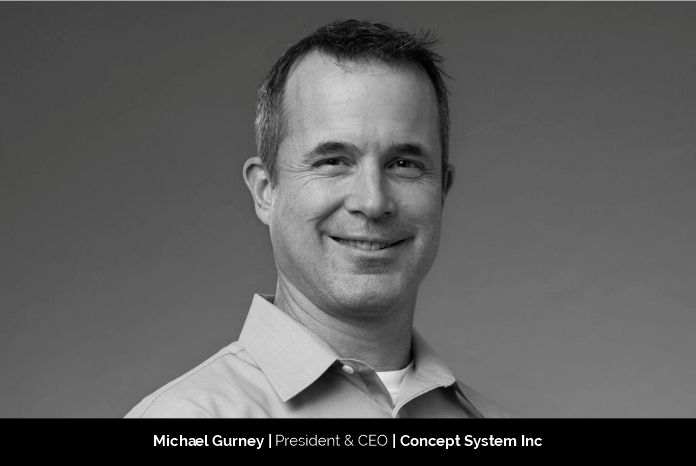Michael Gurney: Concept Systems Unveils How Robots are Transforming Technology featured
The 10 Most Promising Business Leaders to Follow in 2022

Technology has captured every industry and
has enabled every business to grow and thrive in this competitive world. Fast
and efficient technology is always a value add for any business. With advanced
technological solutions and robotics techniques, Concept Systems Inc; is an
Engineering Services Company that ensures optimal efficiency in manufacturing
processes. From basic pick and place robotics applications, to advanced bin
picking solutions and inspection systems using machine vision, Concept Systems
Inc. helps manufacturers address their business challenges. As we highlight
their incredible journey, we are also privileged to share a few insights from
the CEO of Concept Systems Inc; Michael Gurney.
The Beginning of a Remarkable Journey
While he was founding the company Michael
wanted a name that encapsulated the value that he was setting out to bring to
their customers. He knew that with custom automation, you are typically
starting with a blank sheet, and how you solve the problem can take on many
forms. Therefore, he believed, to do it right, you spend a lot of time
conceptualizing ideas, weighing those ideas against the customer’s needs, and
ultimately settling on the right system. With the right direction and a clear
perspective, he moved forward and incorporated Concept Systems in 1999.
Concept Systems is an Engineering Services
company, serving manufacturing/processing customers, focused on turnkey
retrofits, new plant/line integration, robotic work cells, custom mechanical
systems, manufacturing intelligence (IIoT/Industry 4.0) and on-going service
and support. Concept offers services to handle complete projects from original
concept, through design and development, to installation, commissioning,
training, and on-going support. Concept will also offer these services
individually in cases where they are not doing the entire project and the
customer just wants them to supplement their team.
The Challenges and Setbacks of a Growing
Business
Most of Concept projects are capitalized.
The challenge is that they are large projects that require being budgeted, with
many layers of approval. When the economy constricts, it puts a lot of pressure
on manufacturers and makes them hesitant to invest. However, they have grown
primarily through the development of long-term relationships with several key
customers. They have also grown by adding service offerings and have also been
successful in helping start-ups; those with an idea and a market but needing
automation to bring the two together effectively. Concept’s manufacturing
partners are also very important to them. They partner with best in class
suppliers to deliver their solutions. Being a Rockwell Solution Partner, RIA
member, Platinum Integrator, FLIR Authorized Distributor, and a Certified CSIA
member means Concept is committed to maintaining expertise in selecting and
integrating the supplier’s products. Concept has received several industry
certifications/awards that are worthy of note; they have won supply chain
awards as a top supplier from Bechtel in 2007, 2015, and 2019, they have
received several awards from FANUC including the 2014 and 2016 Outstanding
Sales Growth Award as well as the 2014 and 2016 Sales Leadership Award. In
addition, they were Control Engineering Magazine’s 2007 and 2016 Integrator of
the Year.
These rewards and recognitions bear witness
to their hard work and dedication that motivates the team to overcome
manufacturing challenges.
The Distinctive Factor of a Successful
Company
Concept is unique in that they have a wide
breadth of services that they offer, technologies that they have expertise in,
and industries they can serve. They also have a national presence with offices
in Oregon, Washington, and North Carolina. Another unique aspect is a focus
they have on ‘productizing’ their ideas for the benefit of their customers.
Concept is often in a position where they are developing technology that can be
of benefit to other companies, often in different industries. They are always
looking for those opportunities, which allows them to offer very advanced
technology at a reduced price than if everything was custom and one-off. They
have several robot-centric products deployed; OnGuard, a collision avoidance
software package designed to prevent robots from running into each other, or
other valuable assets, Scan2Path, a laser scanning based system designed to
scan parts and offset the part path based on its unique orientation.
The factor that distinguishes Concept from
the crowd is their structured methodology, that ensures clear communication of
project specifications and expectations through the life of the project. It is
structured in that it requires specific project stop points that require
customer review/approval (communication), prior to proceeding to subsequent
steps. Concept is also very ardent about risk identification and mitigation.
This begins as soon as they start conceptualizing their solutions and is
carried through the life of the project; an on-going process, not a one-time
event. Concept is also very structured in how they plan and schedule their
resources, understanding of course that schedule adherence is a driving factor
in client satisfaction.
The Mind of a Business Leader
Michael Gurney, President and CEO of
Concept Systems has been in the integration business for 26 years, starting out
as a control engineer. “It has been a long journey with us being in business
for 20 years. We have been around long enough that we have seen significant
changes in the market, and obviously a lot of technology advances.”, he says.
Michael’s job as CEO is to define the
strategic direction of the company and drive the execution of that strategy. In
general, this means he is looking at the services they provide, and how they
can best provide them. With what Concept does, it also means continually being
on the lookout for emerging technologies and how they can be applied for their
customers’ benefit. When those are identified it is often an opportunity to
expand the service offering. There is value in being a one-stop shop for
automation for their customers. That does not mean they do everything, but they
are at least familiar with all aspects of automation and know where to turn for
elements outside their expertise.
The Concept Journey Thus Far
The biggest change has been the adoption of
robotics across all industries, expanding beyond automotive, where is about the
only place they were prevalent when the company started. This change has come
about due to the competitive landscape of robotics, the emergence of several
suppliers, and the subsequent price reductions. With reduced prices, more and
more projects pencil out from a Return on Investment (ROI) standpoint. Couple
that with general familiarity and it is rare that manufacturers do not ask
about how robots can benefit them. It is also important to note the advances of
the technology, not just improved speed and payload performance of the robot,
but the ancillary technologies that are combined with the robot to give them
more ‘senses’, or functionality. Vision, laser scanning, and tactile feedback
are just a few examples of how they are broadening the capabilities of
robotics, and has made things like collaborative robots, bin picking, and
collision avoidance a reality.
The Scope for Robotics from the Leaders’
View
“I do not know that it is changing the
business world specifically, as the business world has always sought out better
ways of doing things using technology. Robotics just happens to be on the
forefront of that revolution right now.”, shares, Michael.
“We target robots in areas of repetitive
operations that are currently carried out manually, or where existing equipment
is one-off and unreliable. The net effect is generally, more repeatable results
(higher quality) and improved efficiency (less waste). We cannot always capture
improved productivity directly, as humans are relatively fast, but when you
factor in fewer quality issues, it generally is not even close. This does not
mean we are costing people their jobs! In fact, I would argue we are saving
people’s jobs. Automation, and specifically robotics, is enabling manufacturing
to remain viable in the United States. Without automation, the labor cost
disparity between the United States and some other countries, make
manufacturing in the United States cost prohibitive. Without automation, those
manufacturing jobs go away in the form of wholesale moving of manufacturing
facilities. We have seen this take place in the past, and it is not until
relatively recently that we have witnessed the ‘re-shoring’ phenomenon, which
is made possible by automation.” he adds.
Concept’s Ongoing Plan of Success
Concept is a leader in advanced robotics.
They can handle simple pick and place applications, but also advanced
applications that generally involve the combination of advanced technologies. A
good example would be a vision guided robot, that utilizes laser scanning
technology to build a 3D model of parts passing in front of a robot, and then
dispatching the robot based on the unique features of those parts, as
determined by a software algorithm run on that 3D model, all at a very high
rate of speed. The advancement of these technologies, coupled with the advancement
of the robot technology itself, and the downward pressure on prices all are
creating a tremendous amount of opportunity for robots to be deployed on the
manufacturing and processing floor. The only real roadblocks to these
advancements right now are the perceived risk in robotics. In many
manufacturers’ eyes, robots are still new and therefore represent risk. And
while there are certainly risks, with the right approach, those risks can be
mitigated up front and project success can be assured. Over time, as more and
more applications are performed with robotics, there will be more examples
integrators can point their customers to see and gain assurance of the
reliability of these systems, which reduces the perceived risk and makes it
easier for customers to invest.
The Vision and Mission of Concept
The culture of the company starts at the
top with a clear understanding of their principles. Their Mission Statement
reads, “Team with our customers to achieve manufacturing excellence by
delivering the right automation solutions”. This is a very customer-centric
approach to business, and it guides everything they do, from how they train
their people, to how they conduct their start-ups. Every process they have in
place, they ask themselves how it can provide value to their customer. Those
answers drive them to how they implement their business strategies. As it
relates to innovation, most of their customers do not have time to track
advances in technology and how they can be applied to improve their processes.
Concept has several programs in place that are designed to encourage their team
to continuously monitor these advances in technology. When coupled with their
deep knowledge of their customers processes, built on a commitment to
establishing strong relationships with them, Concept is regularly bringing
ideas to the table for their customers to consider for integration.
Concept’s Vision Statement is, “Lead
manufacturing through the automation age and beyond”. They are motivated by
being leaders in this industry, and they will maintain that as they continue to
grow and expand their capabilities. Concept will never lose their
customer-centric approach that has made them so successful in what they do.














